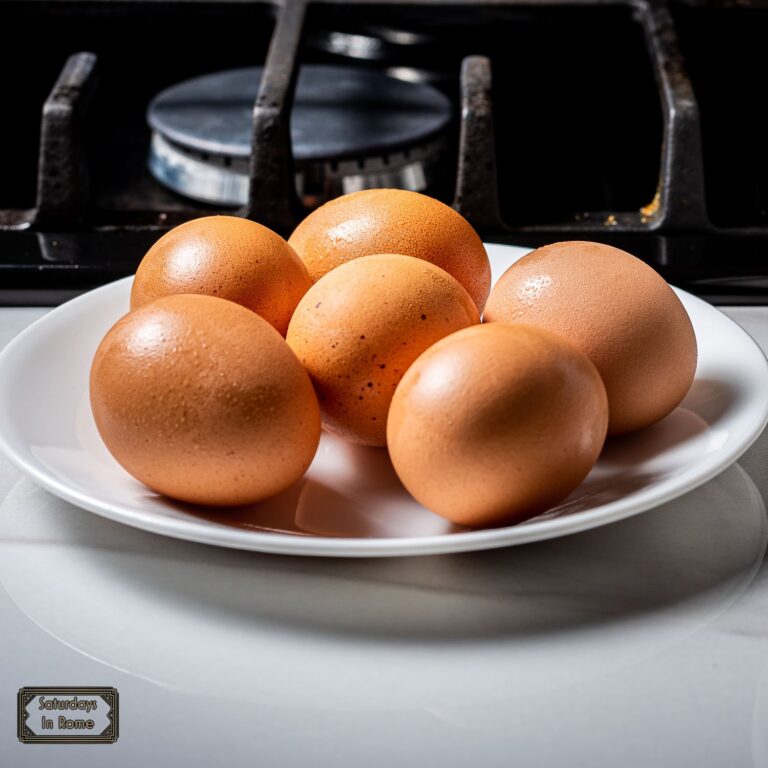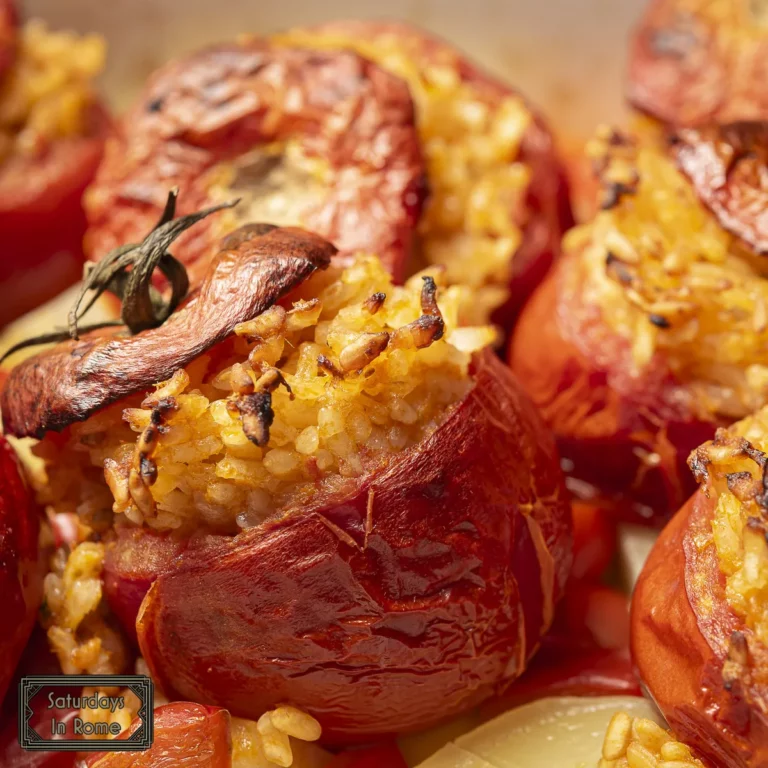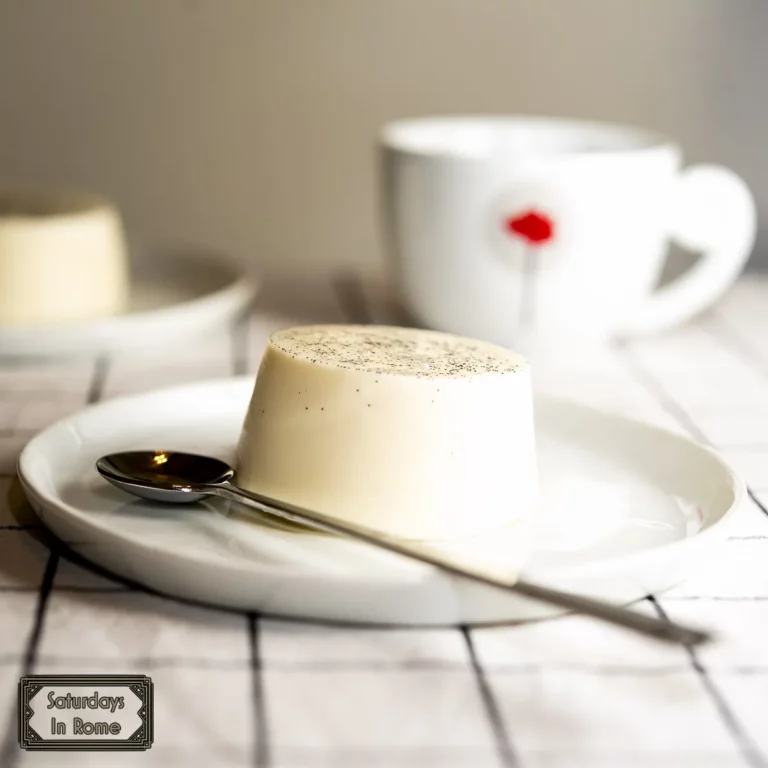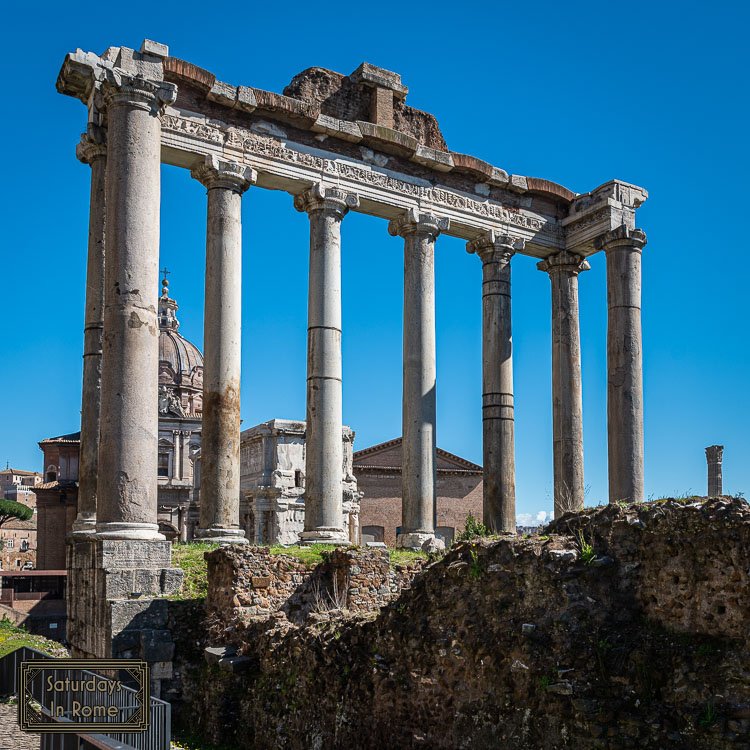Pasta In Rome: The Classics You Must Try
Discover Pasta in Rome with our guide to Carbonara, Amatriciana, Gricia, and Cacio e Pepe – their stories, where to find perfect versions, and how to enjoy them like a local.

The Best Roman Pasta Dishes
I described in great detail in a post about authentic Italian pastas about the important pastas in Rome. This time I want to describe the four classic sauces of Rome: Carbonara, Cacio e Pepe, Amatriciana and Gricia, in greater detail. As a quick review on the pastas that are typically used:
- Spaghetti is a long, thin, solid, cylindrical pasta.
- Rigatoni are tube-shaped pastas of varying lengths and diameters.
- Bucatini are thick spaghetti-like pastas with a hole running through the center.
- Tonnarelli (a.k.a. Spaghetti alla Chitarra) is an egg pasta with a square cross section about 2–3 mm thick.
Need Help Planning?
- Cheap Flights: Find The Most Affordable Flights.
- Accommodations: From 1 to 5 Stars And More.
- Car Rentals: Affordable Travel Across Italy.
- Sightseeing Tours: Explore Some Amazing Tours.
- Buying An eSIM: Stay Connected In Italy.
This post includes affiliate links.
Classic Pasta Sauces In Rome – Pasta alla Carbonara
This is a creamy combination of pasta (usually spaghetti), egg yolks, Pecorino Romano cheese, guanciale and pepper. It is typically served with or without truffles, depending on your choice. Although I described it as creamy, please notice that there is no cream added.
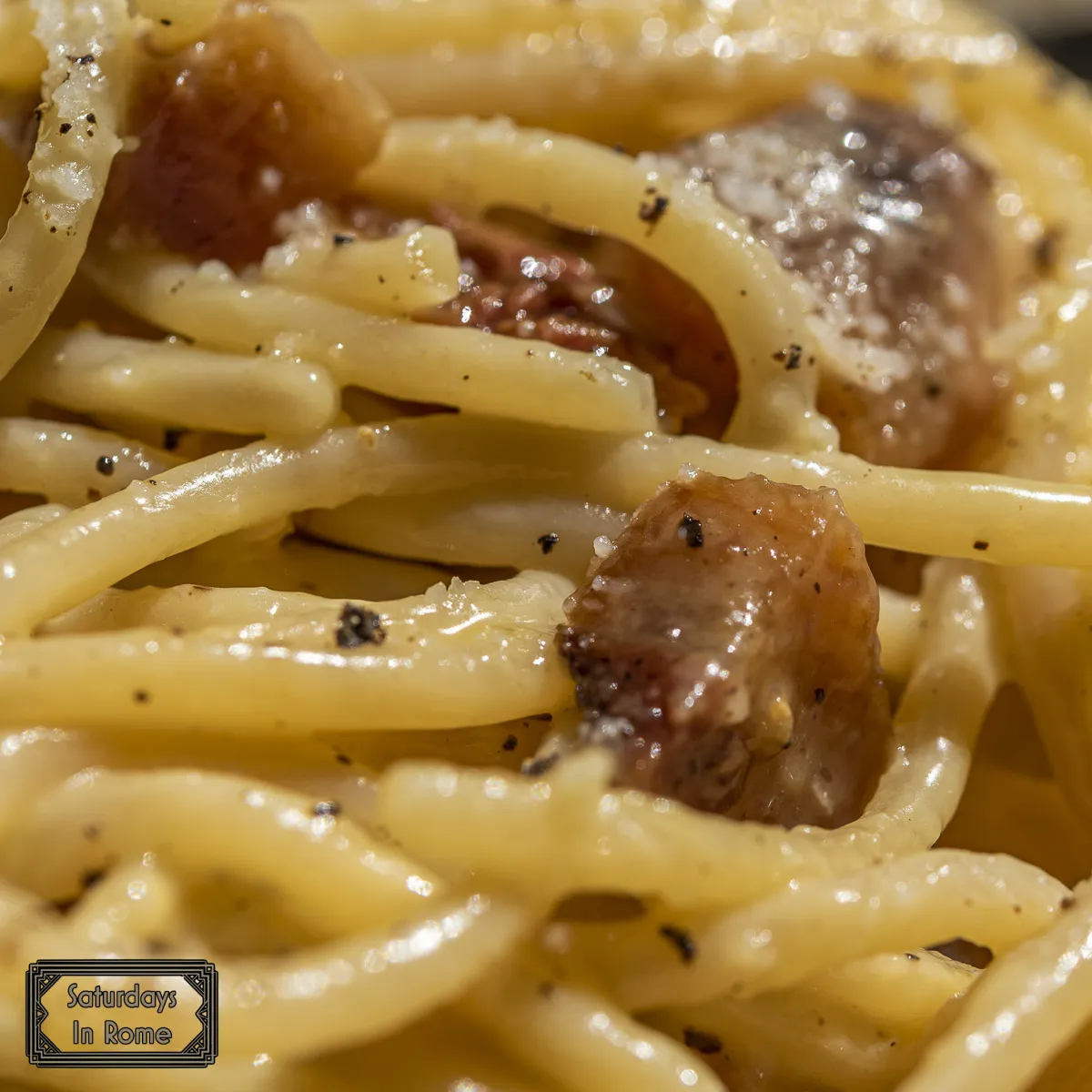
The History Of Carbonara
The recipe for carbonara began to appear in 1944. One theory is that American soldiers, during the Second World War, tasted the cheese and egg pasta from Abruzzo prepared by charcoal burners (carbonari in Roman dialect). From there, adding the bacon (guanciale) came almost naturally.
Another theory claims the birth of carbonara for Naples. The period is the same, we are in 1944. The American troops loved the “street food” they served on the stalls in Naples. They loved the typical wallet pizza and spaghetti cooked quickly and seasoned with cheese and pepper.

Carbonara Variations
I’ve enjoyed this sauce on both Spaghetti and Rigatoni, and these are both popular and proper. Some variations are not acceptable, like adding cream or any greens like spinach or collard greens or adding tomatoes. The one variation I can understand is when you live in a city that doesn’t have guanciale. I would prefer the use of bacon instead of pancetta, but both are reasonable substitutes.
Classic Pasta Sauces In Rome – Pasta alla Gricia
This is basically the same as the Carbonara, but without the egg yolks. When it comes to simple recipes like this, the quality of the ingredients used is really essential. Choose guanciale and don’t give in to the temptation of other meats like pancetta or bacon.

History
There are also many theories on the origins of pasta alla Gricia (or Griscia). Most see it in the eternal struggle between the neighboring cities of Grisciano and Amatrice and in fact it is often defined as Amatriciana in white. For others the term dates back to Rome in the 15th century where “Gricio” was the nickname for bakers. The name Gricio, in addition to the positive sense, quickly took on a derogatory meaning, indicating a badly dressed man with bad manners.
For us today, Pasta alla Gricia is the basis of all the original Roman pastas. In other words, beyond the various theories, it is believed that it is the first pasta used by shepherds who, moving with their flock, brought with them pasta, bacon, pecorino cheese and pepper. All the other Roman pastas Amatriciana, Cacio and Pepe, Carbonara are nothing more than variants of Gricia.
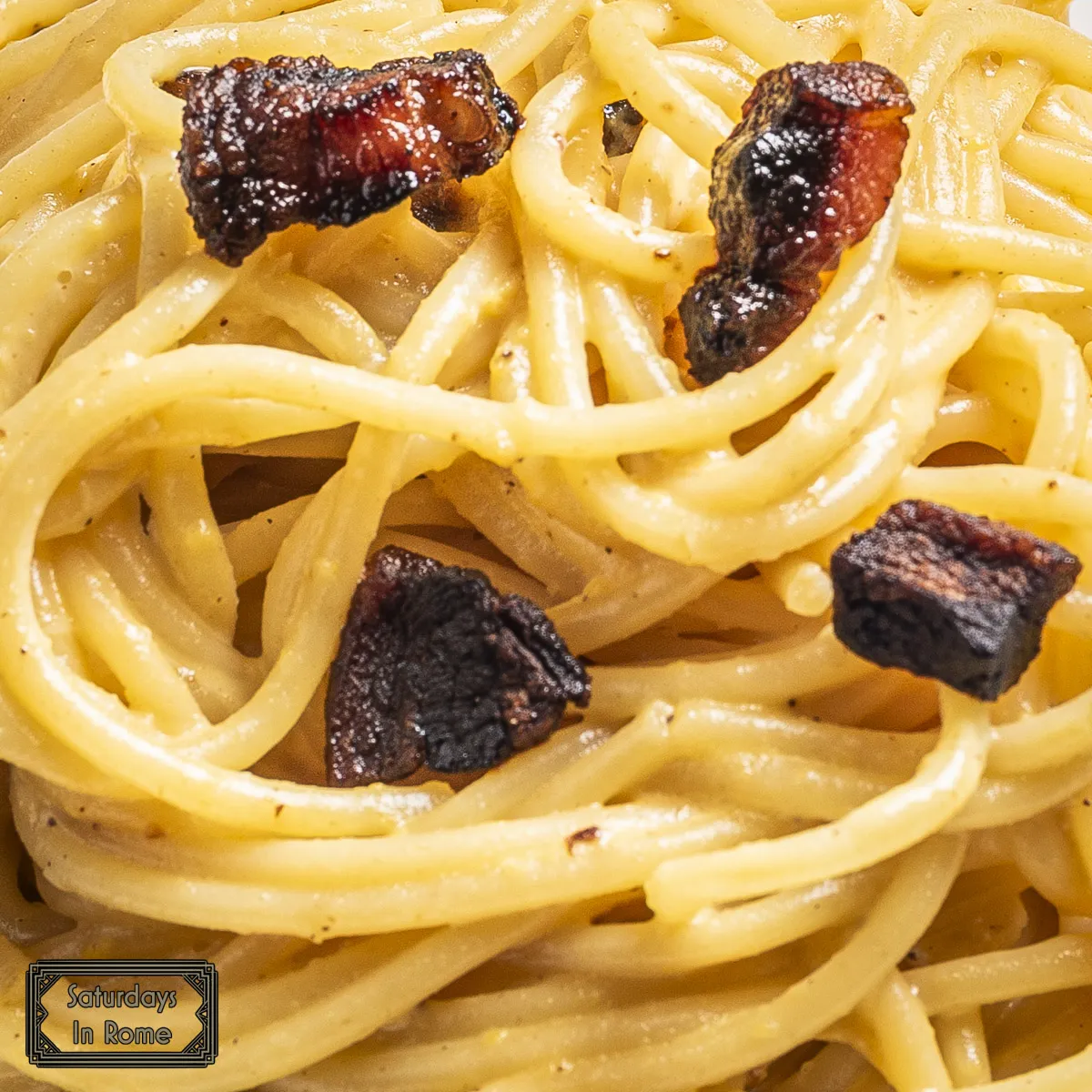
Variations
Being that there are only three ingredients in the sauce, guanciale, cheese and pepper, you are limited in the way you can vary it. Of course the pasta can be changed, and as I mentioned above if you live in a city that doesn’t have guanciale, you can use bacon or pancetta, both are reasonable substitutes. One funny variation that I read said: For those of you on a diet you should eat a portion that isn’t excessive. Sounds easy!
Classic Pasta Sauces In Rome – Bucatini all’Amatriciana
Pasta all’Amatriciana (or matriciana) is a Roman dish but it is originally from the town of Amatrice, in the province of Rieti. There are only three ingredients: pecorino, guanciale and tomato sauce. You should use Bucatini pasta with this, but if you can’t find it, spaghetti will suffice.
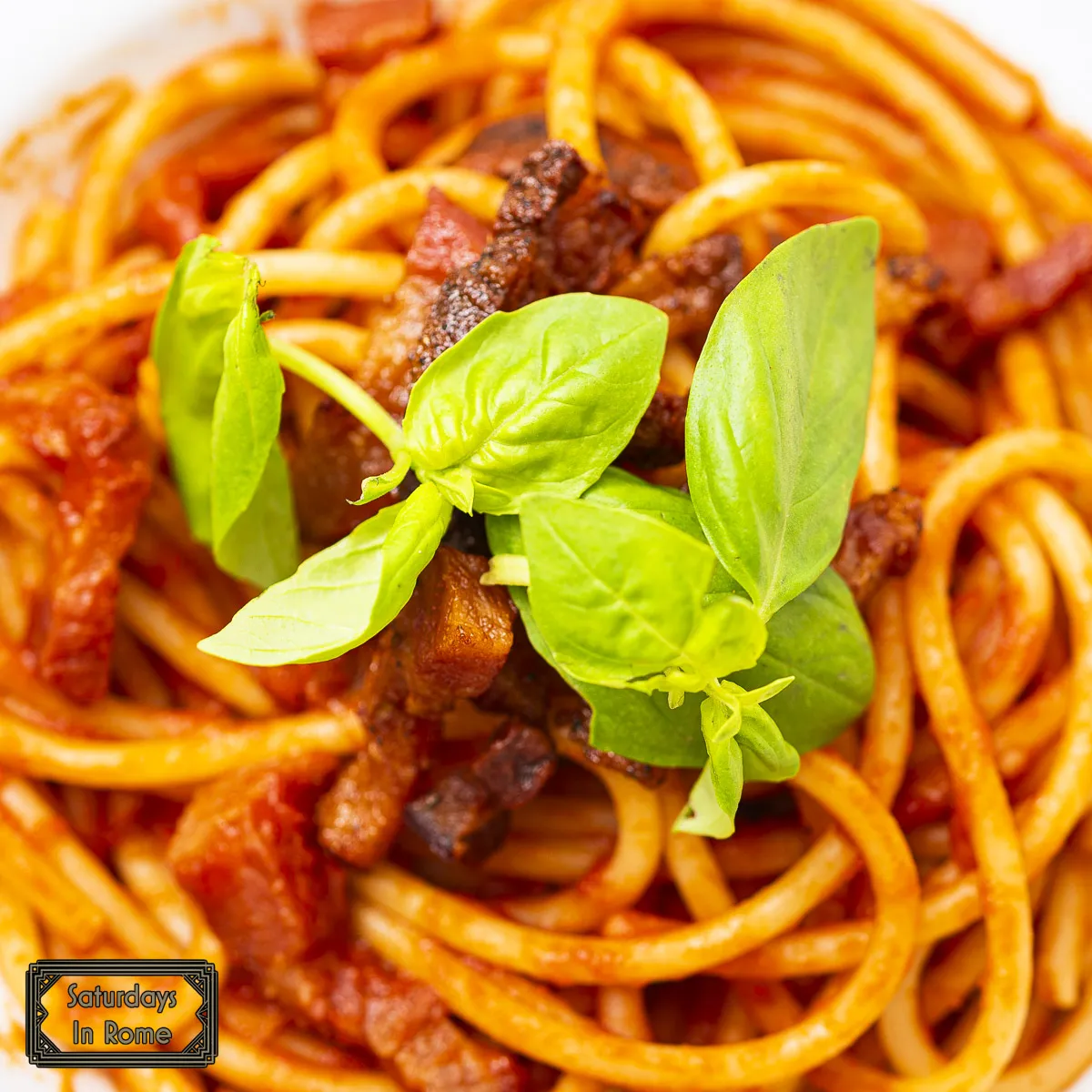
History
We are talking about a peasant dish handed down mostly orally from father to son and, although several historical documents have described its history, they generally disagree. What is certain is that all the various additions provided by the many recipe books do not distort the dish at all.
As mentioned above, Pasta all’Amatriciana originally had a white sauce and was called “pasta alla Gricia”. Centuries ago, the shepherds who lived in the mountains of Amatrice carried in their saddlebags the ingredients necessary for its preparation, including: pieces of bacon, pecorino, lard, black pepper and dried pasta. Later, tomatoes were added to the dish we know today.
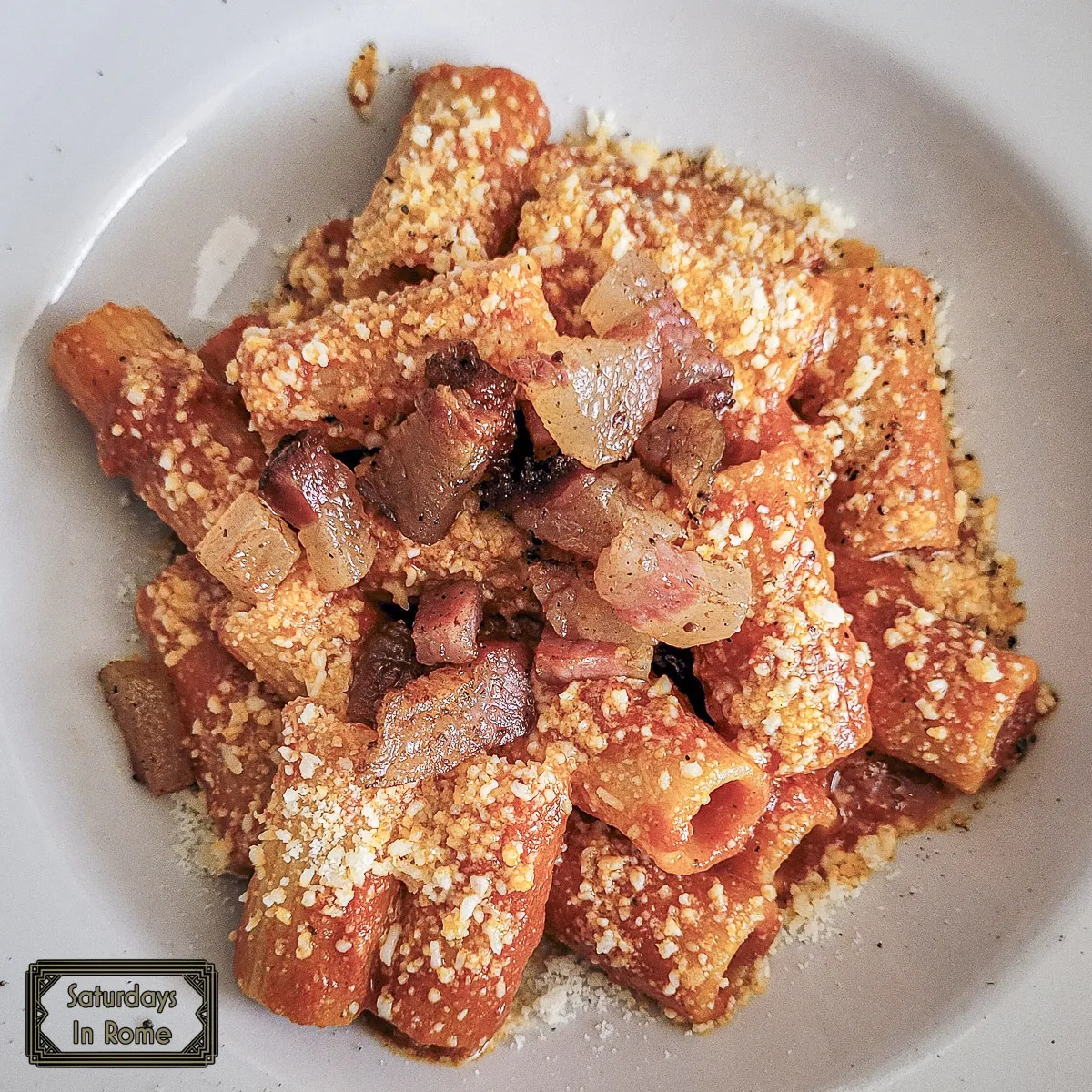
Variations
There are some variations that one should know. First and foremost is the pasta. Bucatini should be used when it is available, but Spaghetti is a common and acceptable substitute. I’ve also enjoyed varying amounts of Pecorino cheese added to the sauce. Sometimes it seems mostly like a cheese sauce and other times you can still taste the tomatoes. Lastly, between the US and Italy, I’ve seen a pretty big range of how much heat to add to the dish. It seems like in the US it is typically spicier and in Italy not nearly as much.
Classic Pasta Sauces In Rome – Cacio e Pepe
The pasta to use here is Tonnarelli, but spaghetti is a good substitute. This is simply a mixture of Pecorino Romano cheese and some pepper. I have seen this dish made a couple of times table-side in a wheel of cheese, but even without the show, it’s a delicious vegetarian dish.
History
The history of this dish, like the others above, originates in the pastures with the shepherds. During the long movements of the flock, the shepherds of the Roman countryside filled the saddlebag with high-caloric and long lasting foods. Among the dried pork cheek there were also a few slices of pecorino cheese, a bag of black peppercorns and a good quantity of dried spaghetti prepared by hand with water, salt and flour.
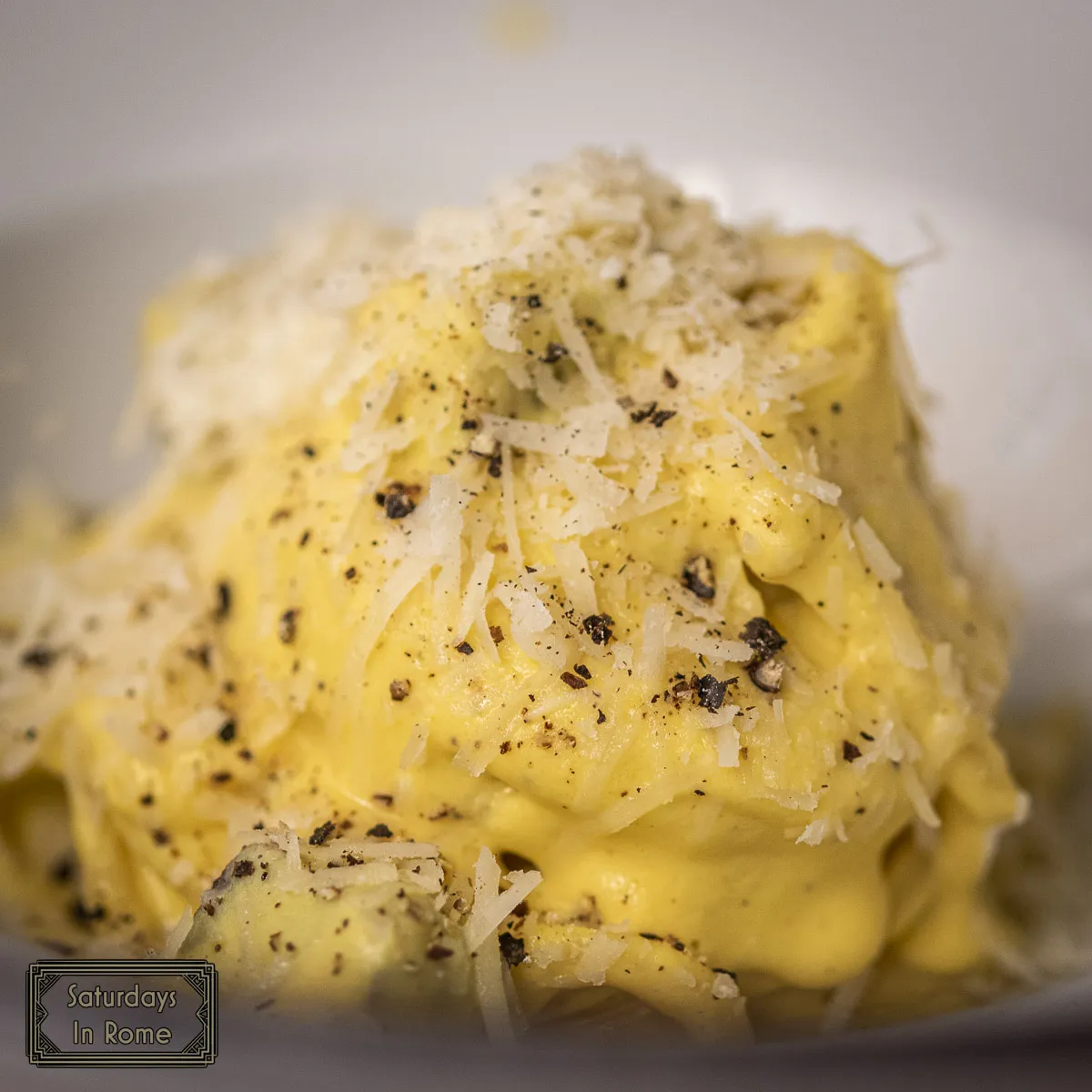
Today, it took little to make the leap and to transform itself from a frugal meal into a typical dish of Roman taverns. According to tradition, the hosts of the time took care to serve a “dry” Cacio e pepe in order to encourage more wine sales. The dish had to make the customers need the wine to swallow the pasta, so the more Cacio and pepper they ate, the more wine they drank.
Variations
Since there are only two ingredients in the sauce, cheese and pepper, there isn’t much room for variation. I’ve seen the dish made with Parmigiano Reggiano cheese, instead of Pecorino Romano, and while it isn’t correct, I think it’s viewed as acceptable. The pasta can be any of the ones I’ve mentioned here, but I strongly recommend Tonnarelli. This chewy egg pasta was a recent discovery for me and I can’t wait to eat it again.
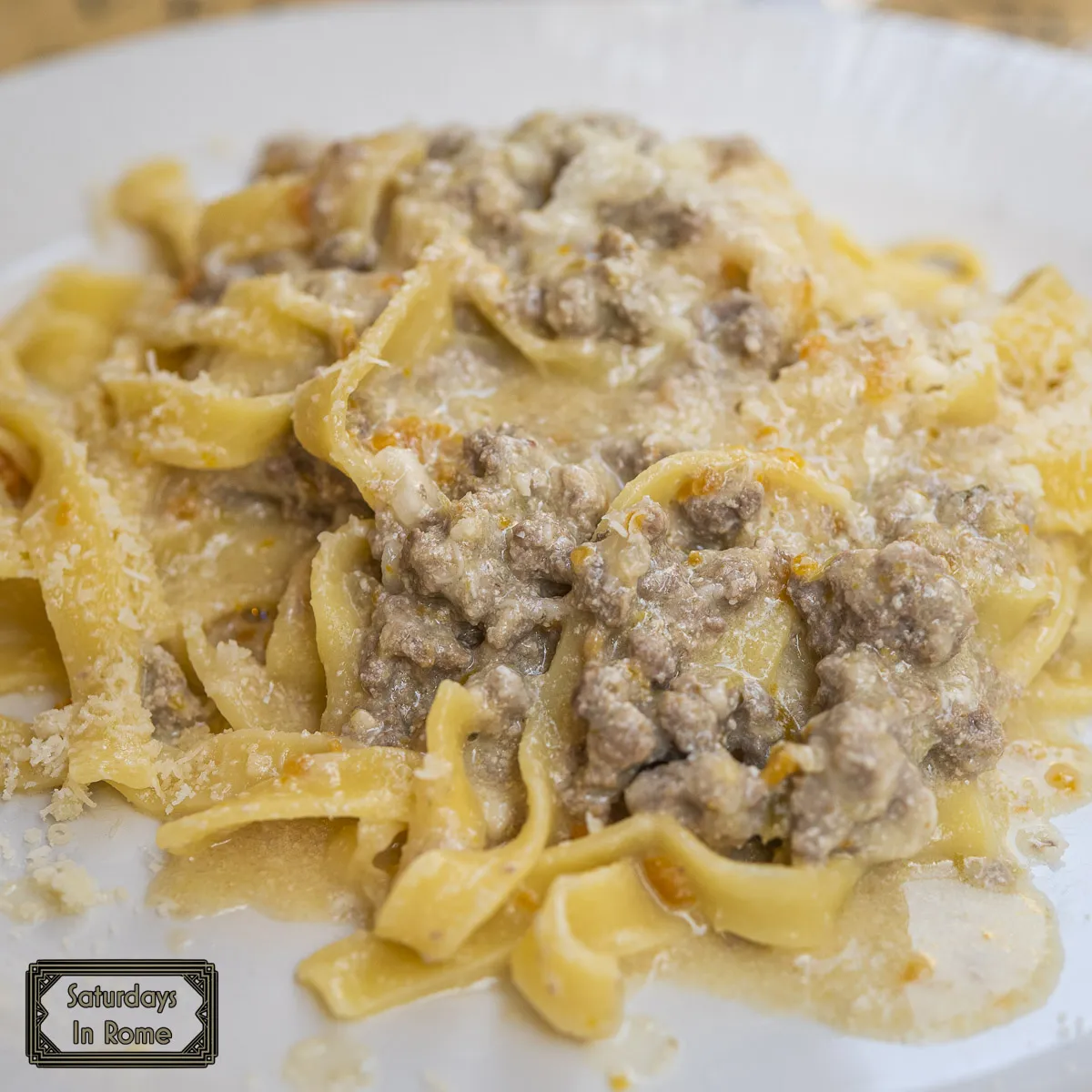
10 Frequently Asked Questions About Pasta in Rome
Here are 10 FAQs that we hope will help you better understand the amazing pasta in Rome:
- What Are The “Classic” Roman Pasta Sauces I Must Try In Rome? – The four classic sauces that everyone should try when they come to Rome are: Carbonara, Amatriciana, Gricia, and Cacio e Pepe.
- What Pasta Shape Is Best For Carbonara, Amatriciana, Gricia, and Cacio e Pepe? – The best pasta and sauce pairings are: Carbonara and Gricia should use Spaghetti or Rigatoni, Amatriciana should use Bucatini and Cacio e Pepe go best with Tonnarelli.
- What Makes Roman Carbonara Different From Versions Elsewhere? – The two biggest mistakes that people outside Rome make with Carbonara are using cream or using anything other than guanciale.
- Where Can I Find The Best Authentic Pasta In Rome (Neighborhoods, Restaurants)? – You can find authentic pasta all over Rome, but you will need to get away from the popular tourist sites to find it. I would recommend heading to the Testaccio or Prati neighborhoods.
- Is It Okay If I Eat Variations (E.G. Substituting Bacon For Guanciale)? Are They “Acceptable”? – Bacon is only acceptable if you can not find guanciale, but the taste will be very different. Guanciale is a unique experience that you need to try. Adding cream or butter is never acceptable.
- Are These Roman Pastas Very Expensive Or Budget-Friendly? – No, the beauty of these traditional Roman dishes is that they are very affordable. A typical plate costs between €12 and €15.
- What Time Are Pasta Dishes Typically Served In Rome (Lunch Or Dinner)? – You can enjoy these during both lunch and dinner.
- Can I Find Good Vegetarian Options Among The Classic Roman Pastas? – The only dish that is vegetarian would be the Cacio e Pepe, so if you are on a restricted diet, be sure to give that dish a try.
- What Should I Avoid When Ordering Pasta In Tourist-Heavy Areas? – Watch the prices. If a place of the pasta is drifting above €15, you might consider looking elsewhere.
- How Has Pasta In Rome Evolved Recently – Modern Or Fusion Versions To Look For? – Like everywhere in the world, classic dishes are reinterpreted by adventurous chefs. For me, the classic versions rule, and you should know what these taste like before trying any variations.
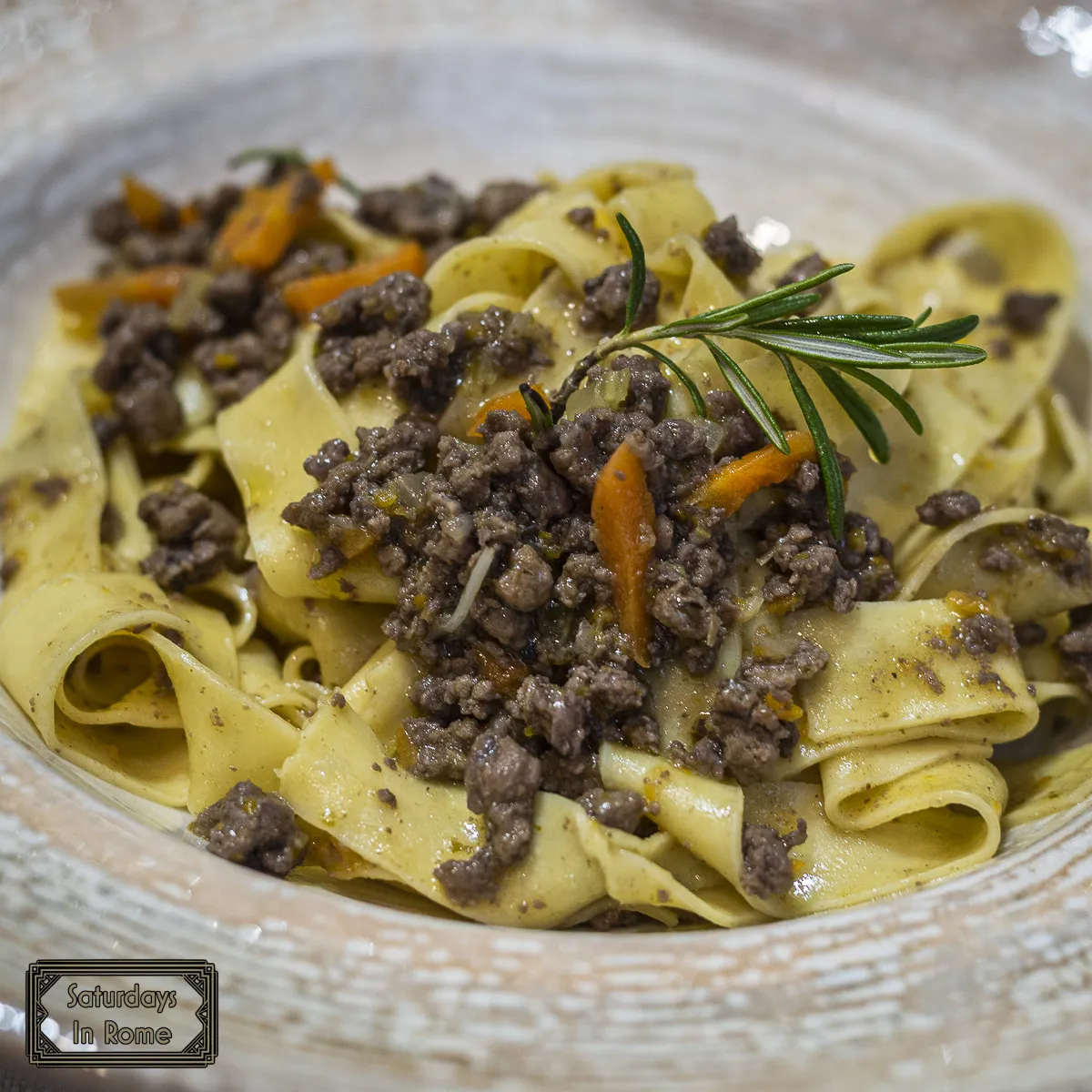
Where To Take Your Typical Roman Pasta From Here
I have only touched on the four traditional pastas in Rome, but there is so much more to enjoy here. When coming to Rome, start with these four, but don’t stop there. Try some Fettuccine, Gnocchi or Cannelloni with almost any sauce and you wouldn’t be disappointed.
If you are interested in more posts about Italian food and sauces, check out these:
- An Easy Pasta Sauce Recipe with Tons of Delicious Flavor
- This Pasta Alla Genovese Recipe Is Delicious And Easy To Make
- This Oxtail Ragu Recipe Is A Classic Roman Favorite
- The Best Neapolitan Ragù Recipe You Will Ever Make
- This Authentic Italian Pesto Recipe Is A Delicious Classic
- An Authentic Italian Bolognese Sauce Recipe You Will Love
- Complete Recipe Menu


